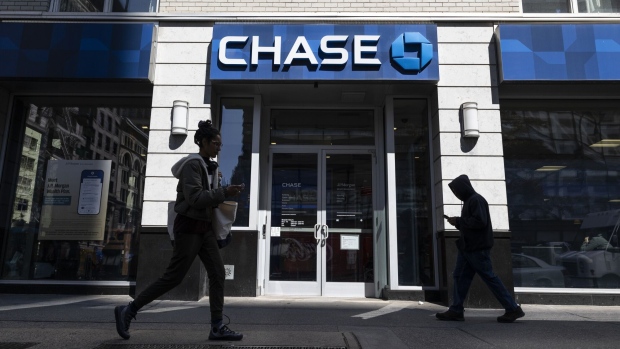Apr 19, 2023
Wall Street Banks Sailed Through a Quarter of Collapsed Lenders
, Bloomberg News

(Bloomberg) -- In a quarter where three smaller lenders collapsed and the nation’s biggest banks staged a rescue as another edged toward the brink, Wall Street raked in gains with little sign of strain. Here are five takeaways from their first-quarter earnings:
Rates Boon
The largest lenders continued to benefit as the Federal Reserve’s rate hikes fueled revenue from their lending operations. JPMorgan Chase & Co. saw first-quarter net interest income surge 49% and boosted its forecast for such revenue to $81 billion this year from a January prediction of $73 billion. At Wells Fargo & Co., that revenue line jumped 45%, and at Citigroup Inc. 23%, compared with a year earlier.
The rate moves that toppled some regional US banks last month also handed opportunities to Wall Street traders. Citigroup boasted one of its best fixed-income trading hauls in a decade as clients reacted to changing rates, while Bank of America Corp.’s unexpected $3.4 billion windfall from fixed-income, currencies and commodities trading — the highest in a decade — helped its profit surpass estimates.
Sticky Deposits
After a surge in customer withdrawals contributed to the demise of Silicon Valley Bank, Signature Bank, Silvergate Capital Corp. and threatened First Republic Bank, investors were on high alert for updates on the flow of money into the big six banks.
In the immediate aftermath of the turmoil, JPMorgan saw about $50 billion in inflows, it said during earnings, though Chief Financial Officer Jeremy Barnum noted that the new deposits may be “somewhat flighty.”
Citigroup saw just under $30 billion of inflows from around March 7th through the end of the month, its Chief Executive Mark Mason said. The inflows coming from corporations and midsize companies during the turmoil will likely be “sticky,” he added.
Bank of America, which declined to provide a specific number, said checking account deposits were already rising and continued to rise from March 10. The bank mopped up more than $15 billion in new deposits in the heat of the crisis, as customers fearful of contagion sought refuge in the firms seen as too big to fail, Bloomberg reported earlier.
Big banks are having to pay a bit more interest to keep their deposits amid a broader migration to higher-yielding alternatives, such as money market funds. Wells Fargo, which said deposits were down 2% quarter-over-quarter and 8% year-over-year, said the average deposit cost rose 80 basis points from the same time last year.
Credit Deterioration
With once-in-a-generation levels of inflation chipping away at savings, Americans are once again beginning to fall behind on payments.
The four biggest US lenders — JPMorgan, Bank of America, Citigroup and Wells Fargo —wrote off a combined $3.4 billion in bad consumer loans in the first three months of the year, a 73% increase from a year earlier. That, combined with additional reserves, boosted provisions at all four institutions to levels not seen since the earliest days of the Covid-19 pandemic.
Citigroup, which more than doubled its provisions for loan losses to $2 billion, said it expected a normalization in credit card losses later this year and into the early part of next. Wells Fargo added $643 million to its allowance for credit losses, with commercial real estate and office loans a primary driver behind the increase.
JPMorgan said its provision for credit losses reflected “net charge-offs of $1.1 billion and a net reserve build of $1.1 billion.” Still, executives at the bank said they’re not taking drastic action in response. Rather, the firm is focused on fine-tuning its real estate portfolio as investors increasingly worry about rising losses on office loans.
“I wouldn’t use the word credit crunch,” Chief Executive Officer Jamie Dimon said during earnings. “Obviously, there’s going to be a little bit of tightening and most of that will be around certain real estate things.”
At Goldman Sachs Group Inc., the platform-solutions division that includes the firm’s burgeoning credit-card effort saw provisions soar to $265 million in the quarter. The Wall Street giant partly blamed the increase on a rise in net charge-offs for its credit-card portfolio.
Economic Outlook
Despite shoring up more funds for souring debt, executives dialed down concerns of a looming credit crunch.
“We haven’t seen any cracks in that portfolio yet,” Bank of America Chief Financial Officer Alastair Borthwick. “The consumer is in great shape.”
Dimon said the US economy continues to generally be on a healthy footing, with consumers with strong balance sheets still spending and businesses in good shape. Still, he invoked his favored weather analogy to describe macro-economic uncertainty ahead.
“The storm clouds that we have been monitoring for the past year remain on the horizon, and the banking industry turmoil adds to these risks,” he said, adding later that the US is eventually going to have a recession.
“We continue to be cautious about the economic outlook,” Goldman Sachs Chief Executive Officer David Solomon said, adding that the firm is well-prepared if the economy weakens further.
Crisis, First Republic
With some indications that the heat of the crisis has abated, James Gorman, the Chief Executive Officer of Morgan Stanley, emphasized how different the regional banking crisis is from 2008 and not “remotely” comparable.
The biggest banks all took part in an extraordinary $30 billion effort to rescue First Republic Bank, the latest firm grappling with depositor panic. The banks’ executives touted how they’d been able to help prop up the ailing institution.
“We are glad to have been in a strong position to help support the US financial system during the recent events that impacted the banking industry,” Wells Fargo Chief Executive Officer Charlie Scharf said.
His bank contributed $5 billion to the effort, which involves each firm parking money at First Republic for at least 120 days.
“All of us did the right thing,” Dimon said during the bank’s earnings call.
©2023 Bloomberg L.P.


